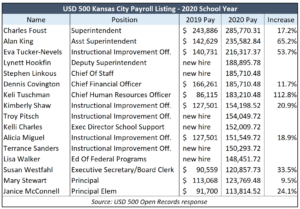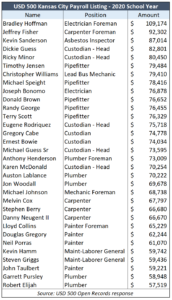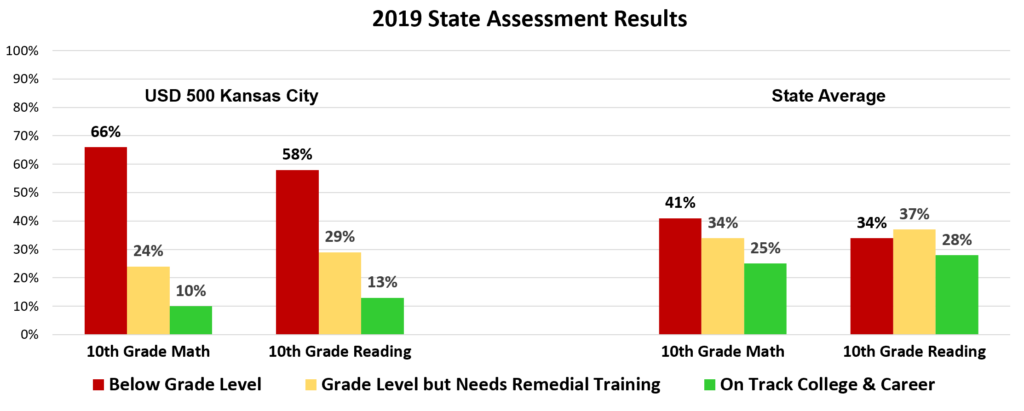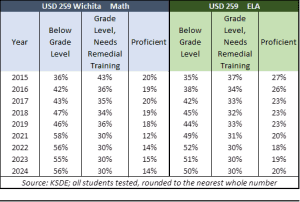USD 500 Kansas City gave Superintendent Charles Foust a 17% pay increase last year, while the approximate $92 million spent on teacher pay was 1% less than the previous year and the total spent on non-teachers increased 3%. Foust, paid almost $286,000 last year, is making about $55,000 more than the previous superintendent, Cynthia Lane, was paid in 2018.
Things like this happen all the time because too many legislators won’t take action to stop it.
The Senate Education Committee approved Senate Bill 353 this year, which would have required school districts to certify that sufficient money has been allocated to Instruction so that students could at least get to grade level. But Senate Majority Leader Jim Denning (R-Overland Park), who controlled the Senate calendar, wouldn’t allow the bill to be debated on the floor and effectively killed the bill.
Over 70% of registered voters say school districts should be required to provide legal certification that they’ve allocated sufficient money to instruction so students can improve, but local school boards and administrators oppose accountability. And since too many legislators fear that standing up to the school lobby will get them unelected, there’s absolutely no accountability for how money is spent, allowing districts like USD 500 Kansas City to reward administrators and shortchange students.
The district’s response to an Open Records request from the Sentinel’s parent company, Kansas Policy Institute, shows Foust wasn’t the only administrator to get a big payday.
 Assistant Superintendent Alan Kin was paid 65% more, to over $235,000. The district wouldn’t say whether this or any other big increases came from payouts of unused sick or vacation time.
Assistant Superintendent Alan Kin was paid 65% more, to over $235,000. The district wouldn’t say whether this or any other big increases came from payouts of unused sick or vacation time.
Eva Tucker-Nevels’ pay jumped 54%, to more than $216,000, while Chief Financial Officer Dennis Covington got a ‘small’ 12% increase to $185,710. Chief Human Resource Officer Keli Tuschman more than doubled her pay, going from $86,115 to more than $183,000, and Susan Westfahl, Executive Secretary and Board Clerk, got a 34% boost to almost $124,000.
USD 500 also hired five new administrators making $148,000 or more, and Superintendent Foust hired a new Chief of Staff at almost $189,000.
The complete payroll listing can be downloaded at KansasOpenGov.org.
 The Kansas City district is notorious for paying in-house maintenance staff far more than market wages, and this year is no different.
The Kansas City district is notorious for paying in-house maintenance staff far more than market wages, and this year is no different.
The electrician foreman was paid over $109,000 – more than double the average teacher pay of $53,117. The carpenter foreman received more than $92,000 and an asbestos inspector was paid $87,000.
Two head custodians were paid more than $80,000 and the district had 85 custodians who were paid more than $50,000.
Four pipefitters were paid more than $76,000. The lead bus mechanic made almost $80,000.
Three carpenters made more than $65,000.
Even general laborers were paid almost $60,000.
None of these amounts include benefits like medical insurance and pension, which is far more lucrative than most private-sector retirement plans.
By the way, the maintenance positions listed in the adjacent table aren’t the only ones that were paid more than the average teacher pay of about $53,000. There are also more positions in some categories – like carpenter, painter, and plumbers – that aren’t listed, and some categories aren’t listed at all, including brick mason, concrete finisher, and locksmith.
Low student achievement
While administrators’ pay soars, student achievement remains abysmally low in USD 500.
The 2019 state assessment results from the Kansas Department of Education shows 66% of 10th-graders in the Kansas City district are below grade level in Math; 24% are considered to be at grade level but still need remedial training to be on track for college and career, and only 10% are on track.
Results for English Language Arts – labeled here as Reading – are a bit better but still exceptionally low, with 58% below grade level. 29% are at grade level but still need remedial training and just 13% are on track for college and career.
State average results are also much lower than parents and employers are led to believe by school districts.

41% of students are below grade level in Math, and 34% are below grade level in Reading. Only about a quarter of the state’s 10th-graders are on track for college and career.
Legislator reaction
Rep. Kristey Williams (R-Augusta) chairs the K-12 Budget Committee and she’s also a former teacher. She says it’s disappointing when districts widen the pay gap between teachers and administrators.
“Good leaders should never take excessive raises when those percentage raises are not available for teachers. Teachers are essential for the growth and well-being of our students and this is one of our great failures — spending less money in the classroom for teachers and for direct instruction as opposed to bigger budgets used for administrators. This is, in part, why reading and math scores are well below where we want them to be. Our priorities are wrong — it should be kids before CEOs.”
Senate Education Chair Molly Baumgardner (R-Louisburg) says teachers constantly ask legislators what they can do to improve pay, but those decisions are made by local school boards and superintendents; legislators have no control over how districts spend their money.
“It’s demoralizing for teachers to learn that administrators and other non-teaching employees get bigger pay increases.”
Baumgardner says school boards approve pay increases for administrators with no relationship to student achievement.
KPI Education Fellow David Dorsey, himself a former teacher, says lots of pay increases were handed out following the Montoy court-ordered funding increase about 15 years ago, but nothing really changed for students.
From the students’ perspective, it seems that local school boards and superintendents are proving Einstein’s definition of insanity with the latest court-ordered funding increase.



